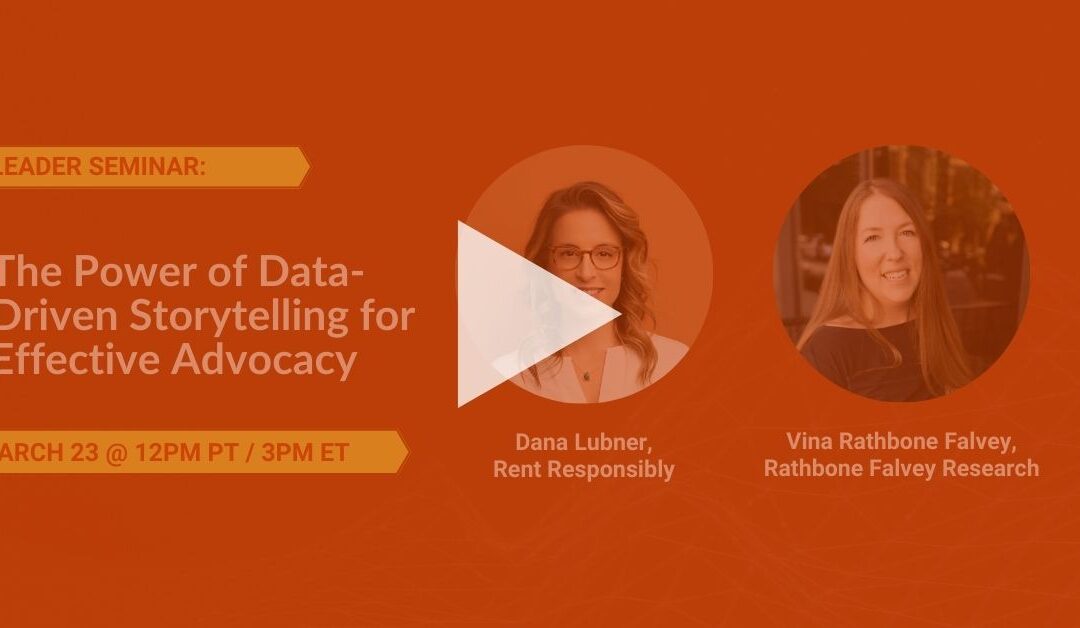“We know that data is powerful. But with a good story, it’s unforgettable.”
Daniel Waisberg, search advocate at Google
Members of the short-term rental community often need to engage in advocacy to highlight their value within the community. Advocacy can include giving testimony at public hearings on short-term rental regulations, talking to people one-on-one, attending community events, and giving interviews to the media.
One of the most powerful ways to persuade decision makers is through data-driven storytelling.
“If you’re talking to people who influence public policy, even just with your own neighbors, you can use these principles,” said Vina Rathbone Falvey, CEO of Rathbone Falvey Research.
And, because all compelling data-driven stories contain common core principles, it’s relatively easy to learn.
Vina and Dana Lubner, head of community development at Rent Responsibly, recently shared some of those common core principles and provided a cheat sheet on where you can find most of the data you’ll need in short-term rental advocacy.
A great data-driven story should:
- Be written for a very specific audience
- Convey a big idea
- Balance emotional and analytical elements
- Be told like a story
- Clarify the data
- Be rehearsed
- Have a follow-up action
Understand your audience
When preparing for a presentation, research on your audience. Consider their demographics, psychographics, motivations, and needs. Knowing your audience will make your presentation more impactful and allows you to keep the interaction conversational rather than lecture-like.
Secondly, keep in mind that your audience wants to know what you can do for them, not vice versa.
Choose data that will be meaningful to decision makers and tailor your presentation for them.
Keep a goal in mind when crafting your presentation. Define how you want to change the audience. Where is the audience starting, and where do you want them to end up at the end of the presentation?
Find common ground with the audience through shared experiences, common goals, and qualifications.
End with the ideal scenario that you’d like the audience to agree with and act on.
If your presentation is for the general public or the media, keep your argument at a high level and omit any industry jargon.
“If your great grandmother couldn’t understand it, rework it until that point,” Vina said, “ which is sometimes hard when you’re an insider working every day … You might even need to sort of overexplain some things that seem obvious to you.”
Convey the Big Idea
Any data-driven story needs to convey a Big Idea.
The Big Idea has two parts:
- A personal perspective
- The reason the audience should care about the idea
Data-driven stories have three parts:
- A Beginning – Lay the common ground and describe “what is.” Next, create tension with what could be. Once you’ve established the gap between what is and what could be, use the rest of the presentation to build the bridge.
- A Middle – The most compelling part where the action happens. Amplify the contrasting themes to build the material for this section.
- A Powerful End – Leave the audience with a heightened sense of what could be by pairing a call to action with a picture of the new reality. Define the new rewards to compel the audience to take action that will be worth the effort. Show the direct benefits to the audience and their sphere.
Balance emotional and analytical elements
Data-driven stories are most powerful when they contain a balance of emotional and analytical elements.
Ask “why” questions to unearth your Big Idea’s emotional appeal, and use stories or anecdotes to add emotional texture.
Analytical elements can include data/evidence, logical arguments/proof, and examples/case studies.
Emotional elements can include anecdotes, metaphors and analogies that make data meaningful, and thought-provoking questions.
Tell it like a story
Data-driven stories are memorable, have sound bites, and contain storytelling principles.
Amplify through contrast, and use metaphors.
Clarify your data
Highlight the data that is important. Explain the why and the how, and use concrete comparisons to express the magnitude of your ideas.
In short-term rental advocacy, there are certain data points you will need to have in order to have a persuasive argument.
Where to find STR-related data points:
- Percentage of total housing inventory
a. Use Key Data or AirDNA to calculate the total number of STR units in the market.
b. Use Census Data to determine how many total housing units are in the market.
c. Divide the number of STRs by the total housing inventory and multiply by 100 to determine the percentage of housing inventory used as STRs. - Size of the “party house” problem
a. Submit a public records request for the total 311 calls and determine what percentage are STR related.
b. Use Key Data or AirDNA to understand what the STR composition looks like. If X percentage of the units are multi-bedroom homes versus small condos, use to emphasize the real size of the “party house” problem. - Economic impact of hospitality
a. Use the Bureau of Labor Statistics data to show the quantity of hospitality jobs. Pair with average pay data.
b. Use Census Bureau data to show lodging tax revenue to the state. Use money amounts.
Remember to rehearse
The best way to cope with stage fright and to prepare for curveballs is to rehearse your presentation.
Vina said she often practices on camera to see what she is going to look like. Be sure to anticipate questions and resistance from the audience so that you are prepared to respond.
Right before the presentation, try doing some breathing exercises or laughing therapy to discharge some of your elevated adrenaline levels and stay calm.
Call to action
At the end of the presentation, leave your audience with an action they can take.
If you’re giving public testimony about an ordinance that might be passed, the follow-up action is saying how you would like them to make their decision.
If your audience is broader than that, think of ways you can extend your reach. A few ideas are to pass out handouts with the data you presented, make a video clip of your testimony and share it on social media, or write an op-ed for the local newspaper.
…
WATCH THE REPLAY
Join the Rent Responsibly Network to access the replay of this and other leader seminars. Once inside the network, join the STR Community Builders Group and visit its resource library.
Already a member? Log in here.



